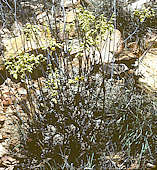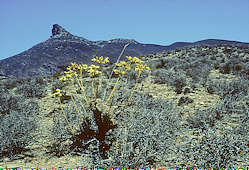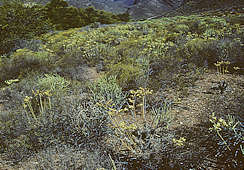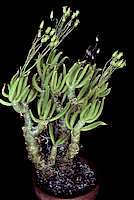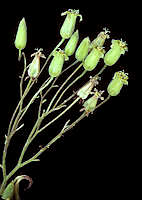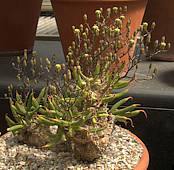Tylecodon H. Toelken (1978)
The name Tylecodon originates as an anagram of Cotyledon.
Tylecodon is a genus of around 46 species of small shrubby plants from South Africa and Namibia, separated from Cotyledon in 1978. Tylecodons range from an inch to over 6 feet in height. Their deciduous succulent leaves arranged in a spiral manner, are produced during the Winter. As this is the growing season, the plants require careful watering during the Winter until the Spring when water should be withdrawn. Flowers are produced after the leaves have been shed in the Spring or Summer although in cultivation the leaves may persist for longer if the plants are watered. My Tylocodons flower freely despite being watered for longer than they should be. They are not hardy but tolerate a cool winter.
The caudiciform habit of many species appeals to many collectors. The thick stems of Tylecodon paniculata (Afrikaans: botterboom) and some other species have attractively peeling bark. In other species the basal part of the deciduous leaves remain on the stem as phyllopodia producing a tuberculate appearance. Many species can be propagated from stem cuttings.
Most species are poisonous, with cardiotoxic and cumulatively neurotoxic Bufadienolides, and must be kept away from animals. Krimpsiekte ("shrinking disease," cotyledonosis) is an economically important disease of livestock caused by consumption of Tylecodons, Cotyledons and related plants. Some Tylecodons are grubbed out by South African farmers to protect livestock and are therefore endangered in their habitat.
|
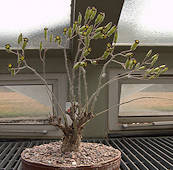
RBG Kew |
Tylecodon atropurpureus Bruyns 1989
The small caudex produces ovate, leaves with a pubescent surface during the Winter growing season. The inflorescence consists of long, thin, branching, hairy stems bearing clusters of small tubular greenish-yellow flowers with yellow insides and purple petal tips.
Native to the Northern Cape of South Africa, growing at elevations of up to 2600 ft above sea level.
|
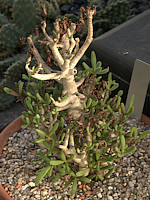
RBG Kew |
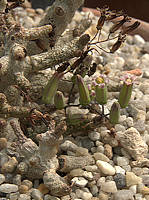
|
Tylecodon buchholzianus (Schuldt & P. Stephan) Toelken 1978
Syn. Cotyledon bucholziana Schuldt & Stephan 1937
This dwarf shrub has a swollen caudex with frequently-branching photosynthetic stems. Cylindrical upward-curving leaves with pointed ends are produced in the Spring but are not really necessary for the plant to grow. Small groups of pink flowers on a long peduncle are produced in early Spring.
Native to a coastal strip from North-West Cape Province of South Africa into Namibia.
|
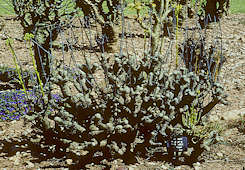
Karoo Botanic Gardens, Worcester, RSA. |
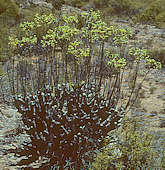
North of Worcester, RSA. |
Tylecodon cacalioides Tölken 1978
This small shrub has thick, knobbly stems branching towards their top and forming a dense clump. The thick yellowish branches have peeling bark and during the growing season, grey-green lanceolate leaves curving upwards and with a slight groove on the upper surface. The long flowering stem carries a cluster of tubular, sulphur-yellow flowers with spreading petal tips.
Native to the Western Cape.
|
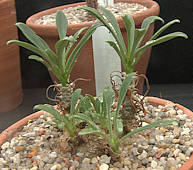 |
Tylecodon grandiflorus (Burman f.) H. Tolken1978 (Rooisuikerblom)
Syn. Cotyledon grandiflora Burman f. 1768
A shrubby succulent growing up to 2 ft tall with a tuberculate stem. The slightly pubescent leaves are deciduous. The inflorescence is a cluster of relatively large tubular orange flowers with 5 petal lobes.
Native to Winter rainfall areas of the South-Western Cape Province. Toxic to livestock.
|
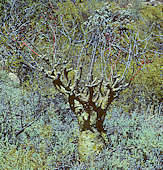 |
Tylecodon paniculatus Tölken 1978 (Botterboom)
This robust shrub has a thick main trunk, branching freely near the top. The smooth yellow-brown bark peels away in patches to reveal green tissues. During the Winter growing season, green ovate leaves are produced around the tips of the branches. The inflorescence, usually produced during the Summer, is a long, branching, reddish stem bearing orange to red tubular flowers with a hairy outer surface.
Native to Namibia and the Northern Cape.
|
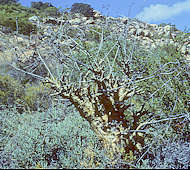
North of Worcester, RSA. |
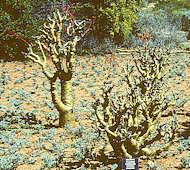
Karoo Botanic Gardens,
Worcester, RSA. |
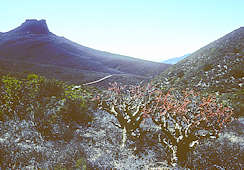
Hillside near Koobeepas, RSA. |
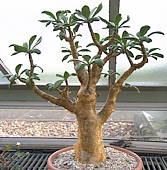
RBG Kew |
|
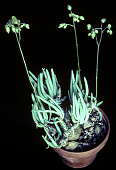
author's plant |
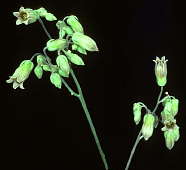 |
Tylecodon pearsonii Tölken 1978 Syn. Cotyledon luteosquamata von Poellnitz 1939
This dwarf pachycaul shrub has greyish stems, patterned with phyllopodia and bearing a cluster of long blue-green 1-3 inch lanceolate leaves around the stem tips. The upper leaf surface is grooved and the underside is rounded. The inflorescence is a cluster of somewhat pendulous green to light brown bells with a pubescent outer surface. The tips of the petals curve outwards.
Native to Namibia and the North-Western Cape. T. pearsonii is said to be so toxic that it should only be handled while wearing gloves. Do not allow animals to eat any part of this plant.
|
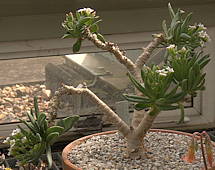
RBG Kew |
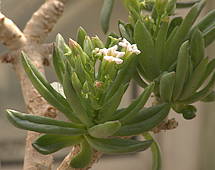 |
|
Above: Tylecodon racemosus Tölken 1978
This small succulent shrub has fleshy slightly pubescent, deciduous leaves with a longitudinal groove along their upper surface.
Native to a small region of the Northern Cape of South Africa into Namibia where it grows among rocks and clefts in rock faces.
|
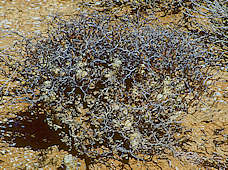
T. reticulatus, Knersvlakte. |
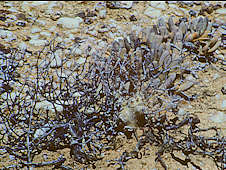
L-H plant is about 9 in tall. |
In the scorchingly-hot sun of their habitat, Tylecodon reticulatus is more compact than in cultivation. Habitat plants are covered with a mass of persistent old flower stems which provide light shade. Most growers remove old flower stems from their plants, producing a different appearance.
Native to Namibia and the South African Cape.
|
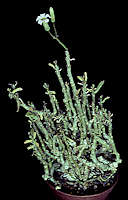
author's plant |
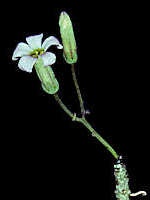 |
Tylecodon schaeferianus Tölken 1978
This dwarf, highly branching plant makes a clump of interwoven, thin gray-green stems up to 4 in tall, arising from a tuberous root. The small (one quarter to half inch), obovate green leaves near to the tips of the branches have a prominent groove on their upper surface. Short flower stems are produced at the tips of the branches and carry one or two small, tubular greenish flowers with large, recurved white to pale pink petal tips.
Native to Namibia and the Northern Cape.
|




